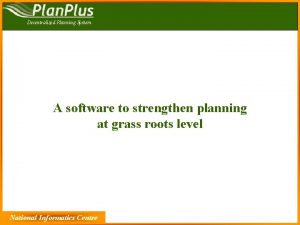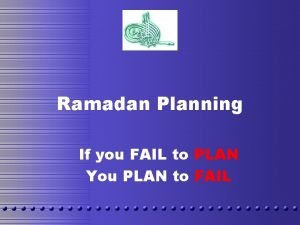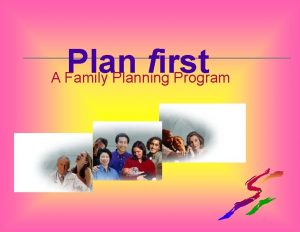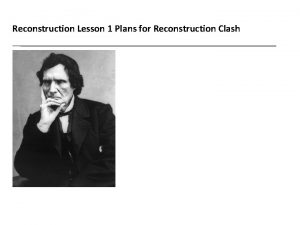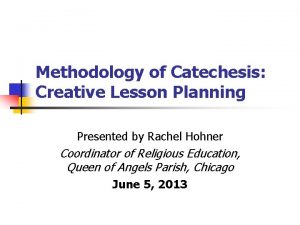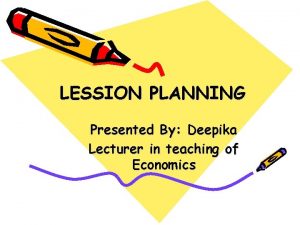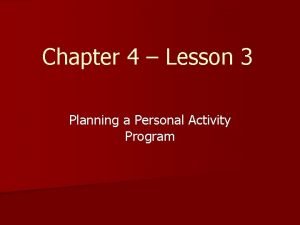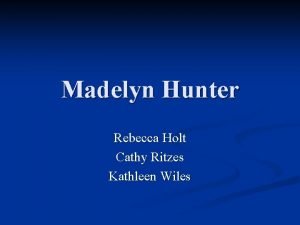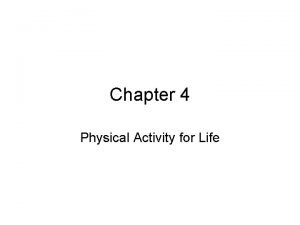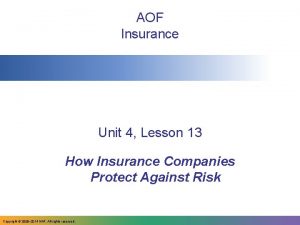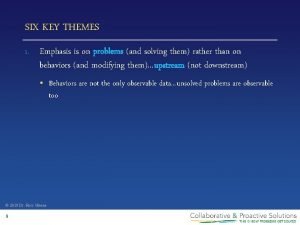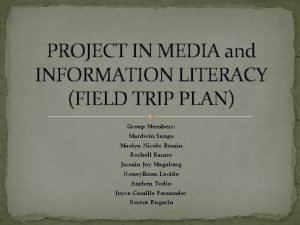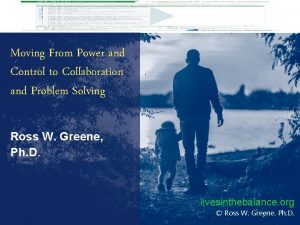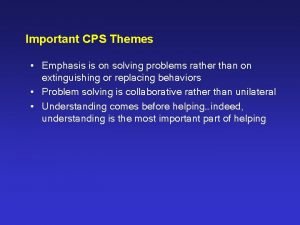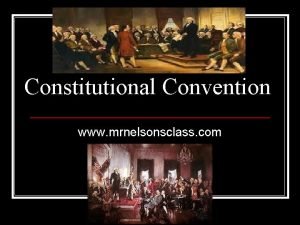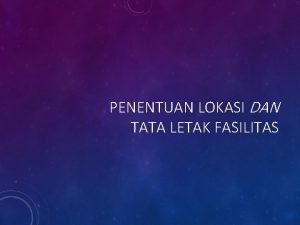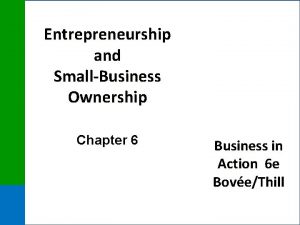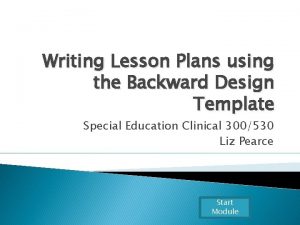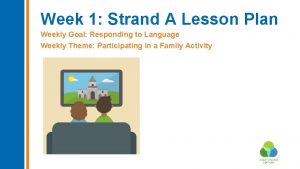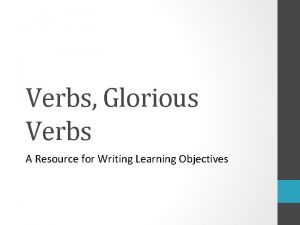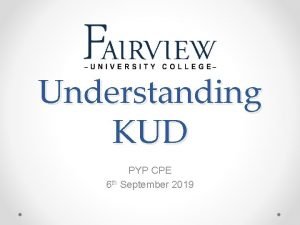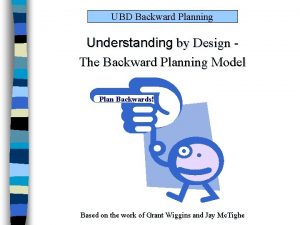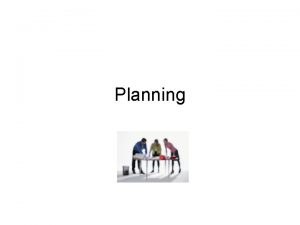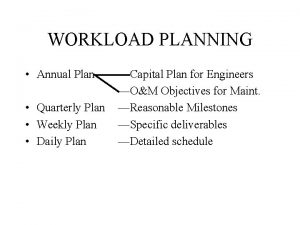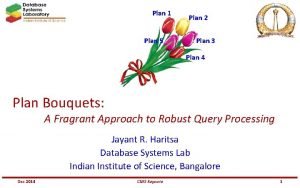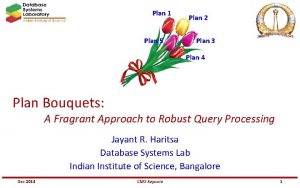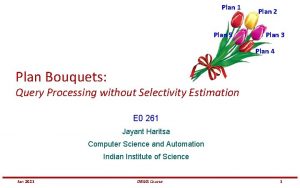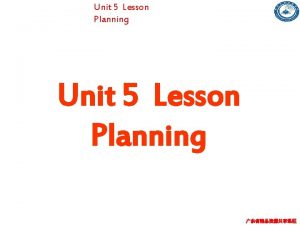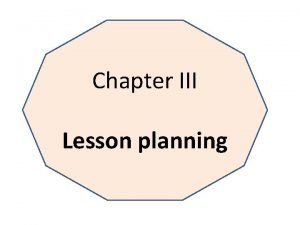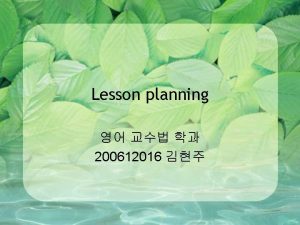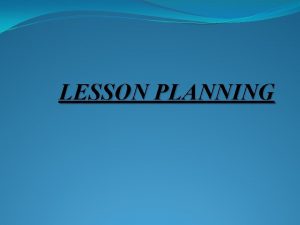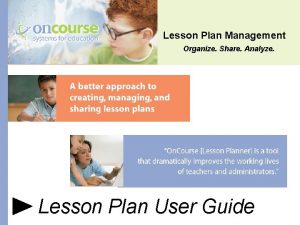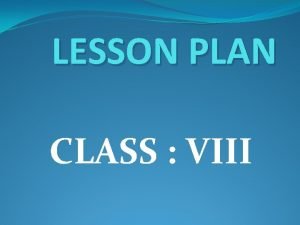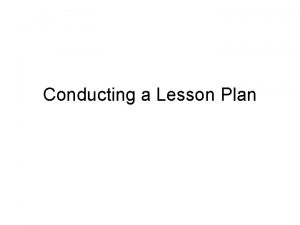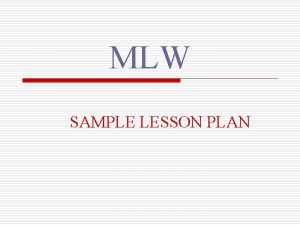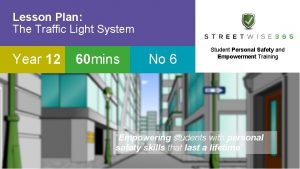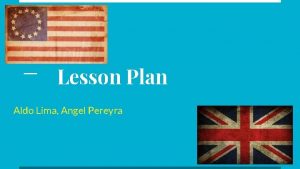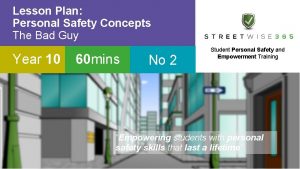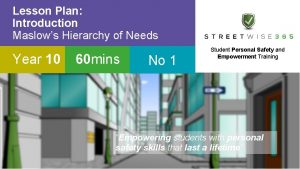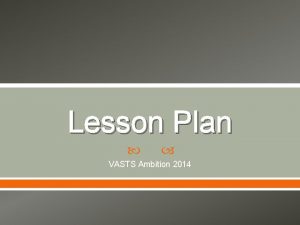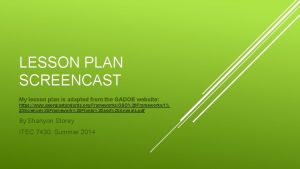LESSON PLANNING LESSON PLAN IS l l a










































- Slides: 42

LESSON PLANNING

LESSON PLAN IS. . . l l a teacher detailed description of the course of instruction for one class. a framework for a lesson. If you imagine a lesson is like a journey, then the lesson plan is the map

It shows you where you start, where you finish and the route to take to get there.

WHY IS PLANNING IMPORTANT l l Teachers need to know what is they want their students to be able to do at the end of the lesson that they couldn’t do before Here are some reasons planning is important:

l l gives the teacher the opportunity to predict possible problems and therefore consider solutions makes sure that lesson is balanced and appropriate for class gives teacher confidence is generally good practice and a sign of professionalism

PRE-PLANNING l l l What will the students already know? What are my goals for this class? What are my objectives for this class? What content will I cover in this class? Etc…

THE FOUR ELEMENTS l l Activities Skills Language Content

Activities When planning we should consider what students will be doing in the classroom. We have to consider the way they will be grouped We should make arrangements about activities almost independently of what language or skills we have to teach. The best lessons includes a variety of activities within a class period.

Students may find themselves standing up and working with each other for five minutes before returning to their seats and working for a time on their own. The same lesson may end with a whole-class discussion or with pairs writing dialogues to practise a language functions

Skills We need to decide which language skills we wish our students to develop. It is determined by coursebook or syllbus. But we need to plan exactly how students are going to work with the skill and what subskills we wish to practice

Language We need to decide what language to introduce and have the students learn, practice, use or research

Content Lesson planners have to select content provoking interest and involvement. Since they know their students personally, it is possible for them to select appropriate content. If the coice of subject and content is to some extent dependent on a coursebook, we can still judge when and if to use coursebook’s topics or whether to replace them with sth else.

However the most interesting content can be made bland if the activities and tasks going with are unimaginative. Similarly, subjects being not fascinating can be used to successfully if the good planner think about how students can best work with them.

THE PLAN l After we did pre-planning, we can prepare the lesson plan.

The Planning Continuum Sequence of activities and decisions involved in identification of aims or needs, and their achievement or fulfillment. It involves three basis steps: (1) Mission building: answering the question, "What are we here for? " (2) Objectives setting: answering the question, "What should we do? “ (3) Mapping and budgeting: answering the question, "How do we make it happen? "

Making A Plan l l l Pre-planning Background Pre-planning Decisions The Plan

Pre-planning Background l l l Profile of the class Level: Intermediate Number of Ss: 31 Age: 18 -31 Resources: Board and projector Content: Transport and different travelling environment Grammer: Should have and Should The students need “waking up” at the beginning of the lesson. They are quite prepared for creative activities. The next grammar item on the syllabus is SHOULD HAVE DONE. The student have not worked on reading lately and need to work more on oral fluency.

Pre-planning Decisions l l The lesson should include an oral fluency activity. The lesson should include the introduction of SHOULD HAVE DONE. It would be nice to have some reading in the lesson. The lesson should continue with the transport theme.

The Plan l l l An oral fluency activity in which students have to decide about five personal possessions they would take into space and compare in groups. Reading for prediction and for gist Create and ending Introduce SHOULD HAVE DONE Ask each other about what they did or did not do, and what they should not and should have done. A space job interview(role play)

l The plan : on the basis of our pre-planning decisions we now make our plan. l The teacher has taken the decision to have the students read the text about a space station and build activities around this. The text does not come from their course book, but is one the teacher has used before.

The Formal Plan l l Class Description and Timetable Fit Lesson Aims Activities, Procedures and Timing Problems and Possibilities

l The Formal plan: Formal plans are sometimes required. l Class description tells us who the students are and what can be expected of them. It can give information about how the group and how the individuals in it behave, as in the following example:


l We also need to say where the lesson fits in a sequence of classes as in the following example. l We will also include information about how the class have been feeling and what kind of activitiesthey have been involved in. (controlled or communicative, pairwork or groupwork).


l Lesson aims: the best classroom aims are specific and directed outcome which can be measured. l Aims should reflect what we hope the students will be able to do, not what the teacher is going to do.


Activities, procedures and timing l The main body of a formal plan lists the activities and procedures in that lesson, together with the times we expect each of them to take. We will include the aids we are going to use and show the different interactions which will take place in the class.

Possibilities and problems l A good plan tries to predict potential pitfalls and suggest ways of dealing with them. It also alternative activities in case we find it necessary to divert from the lesson sequence we had hoped to follow.

l Where we need to modify our lesson dramatically we may choose to abondon what we are doing and use different activities all together. If we have extra time, on the other hand we can use one of our additional, emergency activities suiting the mood of the class


Planning a Sequence of Lesson l l l Before and During Short and Long-term Goals Thematic Strands Language Planning Activity Balance

Before and during However carefully we plan, in practice, it is possible unforeseen things to happen during the lesson, so our plans are continually modified in the light of these

Short and long term goals We may make a student be motivated at first but it is possible motivation’s level to fall dramatically, if the student isn’t engaged or if they can’t see where they are going In order for students to stay motivated they need goals and rewards. Whereas a satisfactory long term goal may be to master the English language, It can seem only a dim and distant possibility at a various stages of the learning cycle.

In such circumstances students need shortterm goals too, such as the completion of some piece of work and rewards such as success on small, staged lesson tests.

Thematic strands One way to approach a seguence of lessons is to focus on different content in each individual lesson. It will certainly provide variety. It might be better, however, for themes to carry over more than one lesson, or at least to reappear, so that students perceive some coherent topic strands as the course progresses.

Language planning When we plan language input over a sequence of lessons, we want to propose a sensible progression of syllabus elements such as grammar, lexis and function. We also want to build in sufficient opportunities for recycling or remembering language and for using language in productive skill work.

Activity balance The balance of activities over a sequence of lessons determines the overall level of student involvement in the course. If we get it right it is possible to meet different learning styles of the students in the class. For weeks or months we would expect students to have received different activities

USING LESSON PLAN l However carefully we plan and whatever form our plan takes we will still have to use that plan in the classroom, and use our plans as records of learning for references

Ø Action and reaction Magic moments Sensible diversion Unforeseen problems Plans as records and research tools. Ø Lets explain these subjects shortly. l Ø Ø Ø

THANKS FOR LISTENING

 Format of micro teaching lesson plan
Format of micro teaching lesson plan Lesson plan on a gift of chappals
Lesson plan on a gift of chappals Strategic planning vs tactical planning
Strategic planning vs tactical planning Goal achievement matrix
Goal achievement matrix Role segmentation workforce planning
Role segmentation workforce planning N planning
N planning Aggregate planning is capacity planning for:
Aggregate planning is capacity planning for: Long medium and short term planning in primary schools
Long medium and short term planning in primary schools Corpus planning and status planning slideshare
Corpus planning and status planning slideshare Aggregate planning is capacity planning for
Aggregate planning is capacity planning for Examples of aggregate planning
Examples of aggregate planning Planplus decentralized planning system
Planplus decentralized planning system If you fail to plan you are planning to fail
If you fail to plan you are planning to fail Plan first family planning
Plan first family planning Andrew johnson’s plan
Andrew johnson’s plan Ppp lesson planning
Ppp lesson planning Catechetical instruction lesson planning
Catechetical instruction lesson planning Lession planning
Lession planning Chapter 12 lesson 3 planning a personal activity program
Chapter 12 lesson 3 planning a personal activity program Planning a personal activity program
Planning a personal activity program Hunter's seven steps of lesson planning
Hunter's seven steps of lesson planning Image alignment
Image alignment Chapter 12 lesson 3 planning a personal activity program
Chapter 12 lesson 3 planning a personal activity program Unit 2 lesson 3 health insurance and financial planning
Unit 2 lesson 3 health insurance and financial planning Economics unit 2 lesson 7
Economics unit 2 lesson 7 Problem solving plan plan b flowchart
Problem solving plan plan b flowchart Academic field trip plan a plan b
Academic field trip plan a plan b Problem solving plan (plan b flowchart)
Problem solving plan (plan b flowchart) Problem solving plan (plan b flowchart)
Problem solving plan (plan b flowchart) New jersey plan vs virginia plan
New jersey plan vs virginia plan Siapa yang membuat stowage plan
Siapa yang membuat stowage plan Perencanaan lokasi adalah
Perencanaan lokasi adalah Mansplan
Mansplan Virginia plan and new jersey plan venn diagram
Virginia plan and new jersey plan venn diagram Va plan nj plan great compromise
Va plan nj plan great compromise People don t plan to fail they fail to plan
People don t plan to fail they fail to plan Building owner chapter 6
Building owner chapter 6 Backward mapping template
Backward mapping template What is a strand in a lesson plan
What is a strand in a lesson plan Psychomotor verbs in lesson plan
Psychomotor verbs in lesson plan Notice writing learning outcomes
Notice writing learning outcomes Kud examples
Kud examples Ubd stages
Ubd stages











